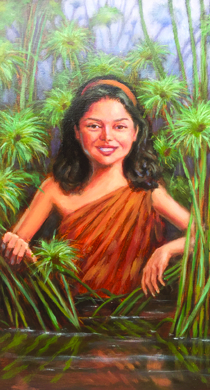
Miriam was the older sister of Moses who kept a sisterly eye on him after he had been placed as a baby in a little boat in the papyrus reeds on the side of the Nile river.
After talking to the Pharaoh’s daughter who had found the baby, Miriam organized for the baby Moses to be looked after by his own mother.
Miriam later was to play an important part in the Israelites forty years in the desert.
One of the meanings in Hebrew for Miriam is: star of the sea.
Background Reading:
Moses is Born
2:1 A man of the family of Levi married the daughter of a descendant of Levi. 2 Later, the woman became pregnant and gave birth to a son. She saw that he was a beautiful child, and hid him for three months. 3 But when she was no longer able to hide him, she took a papyrus container, coated it with asphalt and pitch, placed the child in it, and put it among the reeds along the bank of the Nile. 4 Then his sister positioned herself some distance away in order to find out what would happen to him.
Pharaoh’s Daughter Adopts Moses
5 Then Pharaoh’s daughter came down to the Nile River to bathe while her maids walked along the river bank. She saw the container among the reeds and sent a servant girl to get it. 6 When she opened it and saw the child, the little boy suddenly began crying. Filled with compassion for him, she exclaimed, “This is one of the Hebrew children!”
7 Then his sister asked Pharaoh’s daughter, “Shall I go and call one of the nursing Hebrew women so she can nurse the child for you?”
8 Pharaoh’s daughter told her, “Go,” so the young girl went and called the child’s mother. 9 Pharaoh’s daughter instructed her, “Take this child and nurse him for me, and I’ll pay you a salary.” So the woman took the child and nursed him. 10 After the child had grown older, she brought him to Pharaoh’s daughter, and he became her son. She named him Moses, because she said, “I drew him out of the water.”
Exodus 2:1-10
Other slides in this module:
- Life of Moses – Exodus, Leviticus, Numbers, and Deuteronomy
- 300-year gap between Joseph and Moses
- First 40 years of the life of Moses
- Thutmose I, the Pharaoh or king of Egypt
- Miriam kept eye on Moses after he had been placed as a baby in a boat
- Second 40 years of the life of Moses
- God spoke to Moses out of a burning bush
- Moses was asked to take off his sandals by God
- The third 40 years of the life of Moses
- Aaron’s Staff becomes a Snake
- The ten plagues of Egypt
- 1st Plague – Blood
- 2nd Plague – Frogs
- 3rd Plague – Lice or Gnats
- 4th Plague – Dung beetles
- 5th Plague – Pestilence
- 6th Plague – Boils
- 7th plague – Nut – Egyptian Goddess of the Sky
- 8th Plague – Locust
- Ninth plague – Darkness
- Tenth plague – Firstborn die
- Passover commemorates the Exodus from Egypt
- Moses the friend of God
- Pillar of Cloud by Day
- Pillar of fire by night
- The Chariots of the Egyptian army
- Moses crosses the Red Sea
- Moses’ older sister Miriam sings a song
- Waters of Marah and Elim
- Manna means ‘What Is It?’
- Water from The Rock at Massah
- Moses at Mount Sinai
- The Ten Commandments or Ten Words of God
- The Three groups of Annual Feasts of God
- The Festival of Passover
- The Festival of Unleavened Bread
- The Festival of First Fruits
- The Festival of Weeks or Pentecost
- The Festival of Trumpets or Feast of Shofars
- The Fast of Yom Kippur
- The Festival of Tabernacles
- The Weekly Sabbath Festival
- The Golden Calf, the idol made by Aaron
- Moses with the New Stone Tablets
- 1st five of the Ten Commandments
- 2nd five of the Ten Commandments
- Ark of God
- The High Priest of Israel
- Tabernacle of God
- Aaron and Miriam oppose Moses
- Exploring Canaan by 12 spies
- 37 years in the wilderness
- Aaron’s Rod that budded
- Speak to the Rock “Give Water”
- Death of Aaron
- The Bronze Snake
- Balak Summons Balaam
- Six cities of Refuge for Israel
- Daughters of Zelophehad
- Moses Blesses the Tribes with Three Sermons
- Moses lived for 120 years
- Caleb was the son of Jephunneh
- Joshua – The Fall of Jericho
- Questions and Answers 1-16
- Questions and Answers 17-32
- Questions and Answers 33-49
- Time Line for Life of Moses
- Next Module – Judges or rulers of Israel
- 7 Feasts and a Fast – Introduction
- 7 Feasts and a Fast – PASSOVER
- 7 Feasts and a Fast – UNLEAVENED BREAD
- 7 Feasts and a Fast – FIRSTFRUITS
- 7 Feasts and a Fast – PENTECOST
- 7 Feasts and a Fast – FEAST OF TRUMPETS
- A Fast – YOM KIPPUR
- 7 Feasts and a Fast – TABERNACLES
- 7 Feasts and a Fast – Weekly Sabbath
- 7 Feasts and a Fast – Other Information
- Rosh Hashanah or Yom Teruah (The Day of the Sounding of Shofar)
- Yom Kippur, means “Day of Atonement”
- The Jewish Festival of Sukkot
- Background Information – Life of Moses
- Resources – Life of Moses